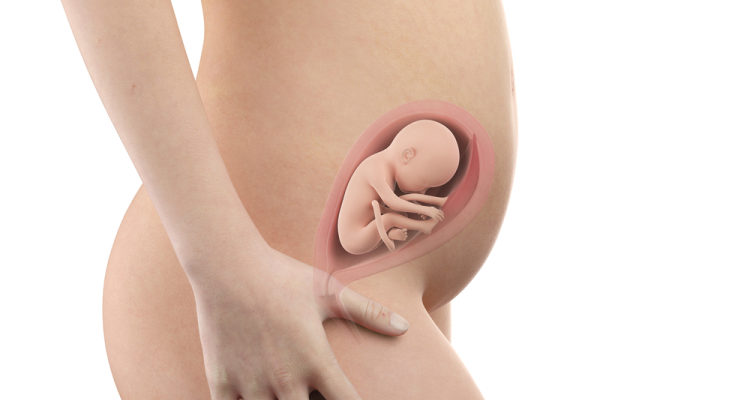
Main content:
Development of 24 weeks fetus
A change in the mother's body at 24 weeks of pregnancy
Doctor's advice about 24 week pregnancy
Maternal and fetal health at 24 weeks
Development of 24 weeks fetus
How does 24 week old fetus develop?
At 24 weeks of age, the baby is the size of a corn. Baby is nearly a foot long and increased about 113g compared to last week.
The baby still receives oxygen across the placenta. But once born, your baby's lungs will begin to work and get oxygen. While preparing for that, your baby's lungs will develop the ability to produce surfactants. This is a substance that keeps the air sacs in the lungs from leaking and holds them together as we exhale and allows us to breathe properly.
Because the inner ear - the part that controls balance in the body - is now fully developed, a 24-week-old baby can know whether he or she is upside down or rising while moving in amniotic fluid.
A change in the mother's body at 24 weeks of pregnancy
How does the mother's body change when the baby is 24 weeks old?
The important prenatal test is a glucose test that is usually done from week 24 to week 28. The blood glucose test will help the doctor know if your mother has gestational diabetes . This is a form of diabetes that occurs during pregnancy and can cause problems in babies, such as hypoglycemia. Gestational diabetes can also increase a woman's chance of having a C-section because it can cause a large pregnancy.
During the diabetes test , the mother will be given a sugar solution and then blood is drawn. If your blood sugar is too high, you will have to do other tests and the doctor will discuss this with you. Gestational diabetes can often be controlled by having a planned diet, exercising regularly and sometimes taking medications, such as daily insulin.
What are the things you need to pay attention to?
The stomach during pregnancy may itch, and it may become more itchy over time, especially around 24 weeks of age. This is because as the womb grows, the skin expands quickly and loses moisture, causing irritation and discomfort. Please try not to scratch your skin because it will only make you feel more itchy and may cause skin irritation.
Moisturizer can temporarily curb the itch, so it should be applied regularly. Anti-itch lotions such as calamine or a bath with oat milk may provide even more relief from itching. However, if you have itchiness that is not related to dry or sensitive skin or a rash on your abdomen, see your doctor early so you can have a closer examination.
Doctor's advice about 24 week pregnancy
What should mothers discuss with doctors when fetus is 24 weeks old?
Around 24 weeks old, the mother's uterus can begin training for labor and delivery. It begins to train muscles to power up great tasks later. These triggering contractions are called Braxton Hicks uterine contractions . They are painless and feel like pressure near the tip of the uterus or in the lower abdomen and groin.
Braxton Hicks physiological contractions are also known as false labor because they are very different from actual birth contractions. Braxton Hicks Mounds occur on an irregular schedule of varying lengths and intensities while true birth contractions often follow the correct pattern, lasting for longer, stronger and closer together. Therefore, it is easy to confuse Braxton Hicks contractions with real birth contractions.
Contact your doctor right away if you have contractions that are worrying you, especially if they become painful or constrict more than 6 times in an hour. The biggest difference between actual birth contractions and Braxton Hicks contractions are the effects on the mother's cervix. With Braxton Hicks contractions, the mother's cervix will not change while during actual labor contractions the cervix begins to dilate. You may need to see a doctor to determine which contractions are real.
What tests do you need to know?
During the 24th week of pregnancy, it has become a good habit to see your mother's doctor. You can expect the doctor to check for some of the following items, although there may be differences depending on your specific needs and the doctor's examination:
Measure your weight and blood pressure
Urine test to measure sugar and protein
Check the fetal heart rate
Measure the size of the uterus by touching the outside (feel it from the outside) to see how it correlates to the due date.
Height of the fundus (top of the uterus)
Check for swelling of the hands and feet, check for varicose veins in the legs
Symptoms the mother experienced, especially those that were not normal
Have a list of questions or issues you want to discuss with your doctor.
Maternal and fetal health at 24 weeks
What do mothers need to know to ensure safety during pregnancy?
If you are pregnant 24 weeks pregnant, you can take an antacid as long as there is no more than the recommended dose on the label, there should be no problems. If you take too much antacids, you may be constipated, but this will not harm your baby.
You should refrain from waxing your face or body during your baby's growth. Although there is no evidence that using hair remover increases the risk of birth defects in babies, mothers can minimize any of these risks by rinsing the skin with cold water first (to tighten pores. ), wax in a well-ventilated place and limit the amount of time using the product on the skin.
aFamilyToday Health does not offer medical advice, diagnosis or treatment.












